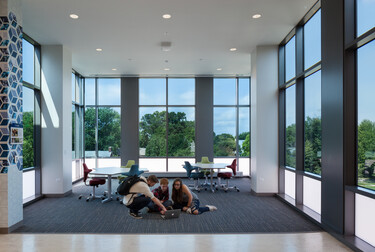Real Estate Value of Daylighting and Views

The number of studies demonstrating the positive effect daylight has on human beings, from health to cognitive performance, is vast. Building owners and designers recognize this, and it is part of the reason so much glass is used in modern buildings. Similarly, there is ample data suggesting modern office workers want daylight. While the occupant benefits are clear, the real estate value added of dynamic glass for buildings has been more difficult to quantify for developers who are focused on their bottom line.
The Business Case for Daylighting
Daylighting in buildings is directly linked to improved health outcomes. Now, according to a recent study conducted by MIT professor Christoph Reinhart and Irmak Turan of the MIT Architecture Department, there’s a strong business case for daylighting as well.
According to the study, the real estate community measures the value of “hedonic characteristics” that improve the value of a building, such as views and walkability. Using a similar model, Reinhart and Turan determined daylighting’s value by measuring the design criteria sdA (spatial daylight autonomy), which is scored as a percentage. In their study of daylighting in Manhattan buildings, MIT found that high sdA buildings yielded a premium of 5.9 percent than buildings with lower quality daylighting!
When you consider the size of the average office building or education facility, the value add is significant. Simply put, buildings that offer improved daylighting are worth more.
A Premium on Views
Daylighting isn’t the only dynamic glass benefit that can be quantified to show increased real estate value. Buildings offering sweeping views of the outdoors, unobstructed by blinds or shading systems, are also at a premium. After all, there’s a reason hotel rooms with oceanfront views and homes or office buildings with views of a city skyline are more expensive.
This was confirmed by a study conducted in 20051 based on data from hotels, residential areas, and office buildings located in several cities. The study found that views do have economic value and affect the price of residential and office buildings, in particular. Additionally, research conducted on coastal properties in the UK found that an oceanfront view can increase a property’s price by 47 to 82 percent2.
By eliminating the need for shading systems and reducing glare from the sun, dynamic glass can provide an environment that not only improves productivity and mood for occupants but also increases building owners’ bottom lines.
Key Takeaways
The occupant experience has long been a key value proposition of dynamic glass, with good reason. Dynamic glass provides proven comfort and wellness benefits for building occupants. What has been more difficult to demonstrate to building owners and designers is the economic value dynamic glass brings to real estate. But with the support of research like the study conducted by MIT researchers, it’s clear that the daylighting and views provided by dynamic glass bolsters the value of a building and, ultimately, the bottom line of building owners and developers.
- J. Kim, J. Wineman, Are Windows and Views Really Better? A Quantitative Analysis of the Economic and Psychological Value of Views, 2005
- https://www.bbc.com/news/business-23255452